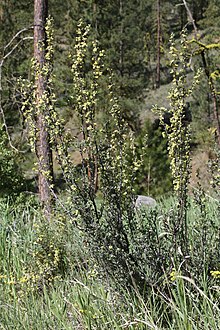Purshia tridentata
| Purshia tridentata | |
|---|---|
 |
|
| Purshia tridentata, Wenas Wildlife Area | |
| Scientific classification | |
| Kingdom: | Plantae |
| (unranked): | Angiosperms |
| (unranked): | Eudicots |
| (unranked): | Rosids |
| Order: | Rosales |
| Family: | Rosaceae |
| Genus: | Purshia |
| Species: | P. tridentata |
| Binomial name | |
|
Purshia tridentata (Pursh) DC. |
|
| Synonyms | |
|
|
Purshia tridentata, with the common name bitterbrush, is a shrub in the genus Purshia of the family Rosaceae. It is native to mountainous areas of western North America.
Common names include antelope bitterbrush,antelope bush,buckbrush, quinine brush, and less commonly deerbrush, blackbrush, and greasewood. Some of these names are shared with other species.
The plant is found from southeastern British Columbia in the north, east to Montana and Wyoming, south to New Mexico, and west in California. It grows on arid mountainsides and slopes.
In California it occurs between 700–3,400 metres (2,300–11,200 ft) above sea level, including in the Peninsular Ranges, Transverse Ranges, and Sierra Nevada, and southern Cascade Range. Further north it occurs at lower elevations, such as at 320–1,065 metres (1,050–3,494 ft) in British Columbia.
Purshia tridentata is a deciduous shrub growing to a height of 1–5 metres (3.3–16.4 ft). It has slender three- to five-lobed leaves 5–20 mm long. It is a nitrogen fixing plant.
The flowers are pale yellow, with five petals 6–8 mm long, and darker yellow anthers. The fruit is a cluster of dry, slender, leathery achenes 0.6–2 cm long.
There are two named varieties of the species:
...
Wikipedia
